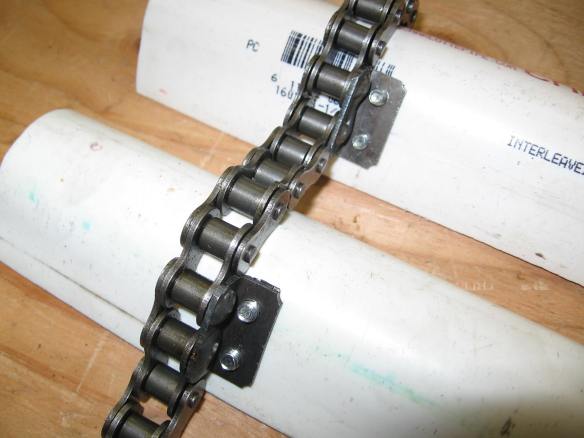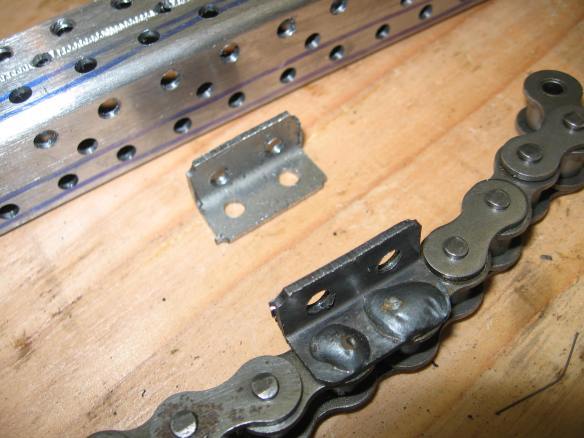Mechanical roller chain is made from hardened steel, so it’s incredibly strong, with even tiny #25 chain able to pull over a thousand pounds. It’s also cheap, with sturdy #40 chain available for under $2/foot. And you can use a chain breaker to disassemble the chain at any link so you can add “attachments” like scoops, prongs for sensors, etc.
In robotics, chain is used for power transmission between moving parts like the drivetrain (to get power from the motor to several wheel axles), but can also be used to make very heavy duty tank-style treads, and we’d like to use it to excavate moon dust for the robot mining competition.

Black #40 steel roller chain holding white PVC scoops. The far side of the scoops dig and lift the moon dust, moving down and left in this weird picture.
The chain itself is cheap, but there are two expensive and difficult to find components: the chain sprockets to put the chain where you want it, and the chain attachments to stick things to the chain.
Sprockets are commercially available, but it’s always hard to find the correct number of teeth and the right bore size to fit your assembly. So I’ve started making my own roller sprockets, using Sprocketeer to generate a .dxf outline and using my CNC cutter to build the part. I actually take a detour through LibreCAD to convert to DXF 2000, then Inkscape with gcodetools to generate gcode tool paths and LinuxCNC to drive the machine.

My aluminum CNC router has just cut a #40 roller sprocket from 5mm steel plate, using a 3mm carbide end mill. This lightweight machine is just barely capable of doing steel, cutting a tiny 1mm deep per pass, and an incredibly slow 20mm/min.
To stick things like buckets or scoops or excavator teeth to your chain, you need a “chain attachment”. There are many kinds of roller chain attachment, but the WA-2 (Wide, one sided style A, 2 holes) seems like the most useful to me. Several places make roller chain attachments for industrial use, like Tsubaki, but if you only need a half dozen they want upwards of $5 per link–plus shipping! This seems like a ridiculous price for a piece of bent metal with four holes in it (two for the roller pins, two for the attachments), so I again used CNC to turn a 1×1 inch steel tubing into an immense brick of #40 roller chain WA-2 attachments. During mining the attachments will get beat up a lot, and any chain failure would be mission-critical, so rather than use the typical flimsy spring-loaded connector link I decided to solidly MIG weld the attachments directly to the roller pins. The chain still moves freely unless I get really out of control with welding.

A 1×1 inch steel tube with 4mm holes every half inch, cut into quarters and parted in one inch sections, makes a pile of #40 WA-2 chain attachments, which can be welded directly to the chain pins. This then provides a secure mount point for mining scoops.
I tapped threads into the exposed holes of the attachments–a #10-24 machine screw tap fits the same 4mm hole as the roller pins. This lets me attach the scoops directly to the chain, which hopefully will be bulletproof for mining. I’m excited about using roller chain for tank-style treads, permafrost mining teeth, coal buckets, and other heavy industrial robotics!
One unresolved question: how do I keep the moon dust from caking to the oil on the chain and clogging things up? I’m considering using a Teflon/Boron Nitride dry lubricant, if it will provide decent corrosion prevention, and if I can figure out how to remove all the existing oil from the chain. Or I could use one of our old ideas and put a flexible fabric dust guard between the chain and the scoops, although this might prevent dust from leaving as well as it prevents it from entering.

Hi.
I am working on a project similar to yours, where we are building a robot to excavate “moon dust.” The issue we are having is the chains seizing because of dust build up. Have you determined a good way to prevent this?
Thank you,
Jasen
Our existing plastic conveyor excavation system is still working, so we haven’t actually gotten around to trying the chain in the dust yet, but I anticipate a number of problems with dust ingestion. First, an oily chain plus dust will form a viscous abrasive mud; I’ve picked out a variety of so-called “dry” lubricants (molebdenum disulphide, teflon, and silicone based) to try to prevent this. On our existing plastic rollers, we ended up needing a long travel spring-loaded tensioner to allow grit and small rocks to crunch through the system while keeping the system running–how is your chain system tensioned? Finally, the simplest solution would be to just use a bigger motor, or push more amps through your existing motor, to keep cranking along despite jam-ups.